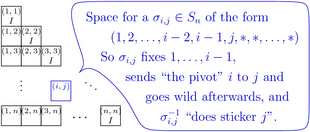10-1100/Homework Assignment 3: Difference between revisions
No edit summary |
No edit summary |
||
| Line 13: | Line 13: | ||
'''Problem 3.''' (Selick) Show that the group <math>Q</math> of unit quaternions (<math>\{\pm 1, \pm i, \pm j, \pm k\}</math>, subject to <math>i^2=j^2=k^2=-1\in Z(Q)</math> and <math>ij=k</math>) is not a semi-direct product of two of its proper subgroups. |
'''Problem 3.''' (Selick) Show that the group <math>Q</math> of unit quaternions (<math>\{\pm 1, \pm i, \pm j, \pm k\}</math>, subject to <math>i^2=j^2=k^2=-1\in Z(Q)</math> and <math>ij=k</math>) is not a semi-direct product of two of its proper subgroups. |
||
'''Problem 4.''' (Qualifying exam, September 2008) Let <math>G</math> be a group and <math>p</math> be a prime. Show that if <math>H</math> is a <math>p</math>-subgroup of <math>G</math>, then <math>(N_G(H):H)</math> is congruent to <math>(G:H)</math> mod <math>p</math>. You may wish to study the action of <math>H</math> on <math>G/H</math> by multiplication on the left. |
'''Problem 4.''' (Qualifying exam, September 2008) Let <math>G</math> be a finite group and <math>p</math> be a prime. Show that if <math>H</math> is a <math>p</math>-subgroup of <math>G</math>, then <math>(N_G(H):H)</math> is congruent to <math>(G:H)</math> mod <math>p</math>. You may wish to study the action of <math>H</math> on <math>G/H</math> by multiplication on the left. |
||
'''Problem 5.''' (easy) |
'''Problem 5.''' (easy) |
||
Latest revision as of 07:02, 15 November 2010
| |||||||||||||||||||||||||||||||||||||||||||||||||||||||||
This assignment is due at class time on Tuesday, November 16, 2010.
Solve the following questions
Problem 1. (Selick) Show that any group of order 56 has a normal Sylow- subgroup, for some prime dividing 56.
Problem 2. (Qualifying exam, May 1997) Let act on by permuting the factors, and let be the semi-direct product of and .
- What is the order of ?
- How many Sylow-5 subgroups does have? Write down one of them.
Problem 3. (Selick) Show that the group of unit quaternions (, subject to and ) is not a semi-direct product of two of its proper subgroups.
Problem 4. (Qualifying exam, September 2008) Let be a finite group and be a prime. Show that if is a -subgroup of , then is congruent to mod . You may wish to study the action of on by multiplication on the left.
Problem 5. (easy)
- Prove that in any ring, .
- Prove that even in a ring without a unit, .
(Feel free to do the second part first and then to substitute ).
Problem 6.
- (Qualifying exam, April 2009) Prove that a finite integral domain is a field.
- (Qualifying exam, September 2008) Prove that in a finite commutative ring, every prime ideal is maximal.
Problem 7. (Dummit and Foote) A ring is called a Boolean ring if for all .
- Prove that every Boolean ring is commutative.
- Prove that the only Boolean ring that is also an integral domain is .




















